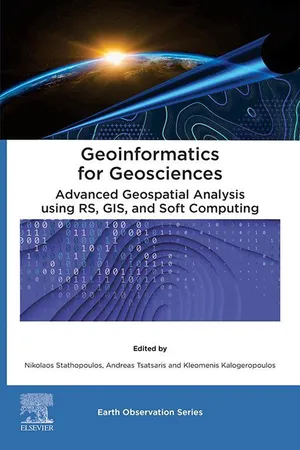
eBook - ePub
Geoinformatics for Geosciences
Advanced Geospatial Analysis using RS, GIS and Soft Computing
- 404 pages
- English
- ePUB (mobile friendly)
- Available on iOS & Android
eBook - ePub
Geoinformatics for Geosciences
Advanced Geospatial Analysis using RS, GIS and Soft Computing
About this book
Geoinformatics for Geosciences: Advanced Geospatial Analysis using RS, GIS and Soft Computing is a comprehensive guide to the methodologies and techniques that can be used in Earth observation data assessments, geospatial analysis, and soft computing in the geosciences. The book covers a variety of spatiotemporal problems and topics in the areas of the environment, geohazards, urban analysis, health, pollution, climate change, resources and geomorphology, among others. Sections cover environmental and climate issues, analysis of geomorphological data, hazard and disaster impacts, natural and human resources, the influence of environmental conditions, geohazards, climate change, geomorphological changes, etc., and socioeconomic challenges.
Detailing up-to-date techniques in geoinformatics, this book offers in-depth, up-to-date methodologies for researchers and academics to understand how contemporary data can be combined with innovative techniques and tools in order to address challenges in the geosciences.
- Focuses on a variety of interdisciplinary applications using Earth observation data, GIS, and soft computing techniques to address various challenges in the geosciences
- Presents both innovative techniques and specific features of the practices described, thus allowing readers to choose the most appropriate method to apply to their specific problems
- Comprehensively details the state-of-the-art methodologies and decision-making tools included to ensure they are easily reproduceable
Frequently asked questions
Yes, you can cancel anytime from the Subscription tab in your account settings on the Perlego website. Your subscription will stay active until the end of your current billing period. Learn how to cancel your subscription.
At the moment all of our mobile-responsive ePub books are available to download via the app. Most of our PDFs are also available to download and we're working on making the final remaining ones downloadable now. Learn more here.
Perlego offers two plans: Essential and Complete
- Essential is ideal for learners and professionals who enjoy exploring a wide range of subjects. Access the Essential Library with 800,000+ trusted titles and best-sellers across business, personal growth, and the humanities. Includes unlimited reading time and Standard Read Aloud voice.
- Complete: Perfect for advanced learners and researchers needing full, unrestricted access. Unlock 1.4M+ books across hundreds of subjects, including academic and specialized titles. The Complete Plan also includes advanced features like Premium Read Aloud and Research Assistant.
We are an online textbook subscription service, where you can get access to an entire online library for less than the price of a single book per month. With over 1 million books across 1000+ topics, we’ve got you covered! Learn more here.
Look out for the read-aloud symbol on your next book to see if you can listen to it. The read-aloud tool reads text aloud for you, highlighting the text as it is being read. You can pause it, speed it up and slow it down. Learn more here.
Yes! You can use the Perlego app on both iOS or Android devices to read anytime, anywhere — even offline. Perfect for commutes or when you’re on the go.
Please note we cannot support devices running on iOS 13 and Android 7 or earlier. Learn more about using the app.
Please note we cannot support devices running on iOS 13 and Android 7 or earlier. Learn more about using the app.
Yes, you can access Geoinformatics for Geosciences by Nikolaos Stathopoulos,Andreas Tsatsaris,Kleomenis Kalogeropoulos in PDF and/or ePUB format, as well as other popular books in Physical Sciences & Business Intelligence. We have over one million books available in our catalogue for you to explore.
Information
Table of contents
- Geoinformatics for Geosciences
- Cover
- Title page
- Copyright
- Table of Contents
- List of contributors
- About the editors
- Chapter 1 Geoinformatics, spatial epidemiology, and public health
- Chapter 2 Quality of life in Athens, Greece, using geonformatics
- Chapter 3 A new kind of GeoInformatics built on living structure and on the organic view of space
- Chapter 4 Geospatial modeling of invasive Aedes vectors in Europe and the diseases they transmit: a review of best practices
- Chapter 5 Deposition and erosion dynamics in Axios and Aliakmonas river deltas (Greece) with the use of Google Earth Engine and geospatial analysis tools
- Chapter 6 Crowdsourced geospatial data in human and Earth observations: opportunities and challenges
- Chapter 7 Google Earth Engine and machine learning classifiers for obtaining burnt area cartography: a case study from a Mediterranean setting
- Chapter 8 On volunteered geographic information quality: a framework for sharing data quality information
- Chapter 9 Natural disaster monitoring using ICEYE SAR data
- Chapter 10 Oil spill detection using optical remote sensing images and machine learning approaches (case study: Persian Gulf)
- Chapter 11 Remote sensing and geospatial analysis
- Chapter 12 Mineral exploration using multispectral and hyperspectral remote sensing data
- Chapter 13 Geographic information systems and remote sensing for local development. Reservoirs positioning
- Chapter 14 An integrated approach for a flood impact assessment on land uses/cover based on synthetic aperture radar images and spatial analytics. The case of an extreme event in Sperchios River Basin, Greece
- Chapter 15 Quantitative comparison of geostatistical analysis of interpolation techniques and semiveriogram spatial dependency parameters for soil atrazine contamination attribute
- Chapter 16 Comparison of “subjectivity” and “objectivity” in expert-based landslide susceptibility modeling
- Chapter 17 Remote sensing and geographic information system for soil analysis—vulnerability mapping and assessment
- Chapter 18 Multiparameter analysis of the flood of November 15, 2017 in west Attica using satellite remote sensing
- Conclusions
- Index
- Index - Continued